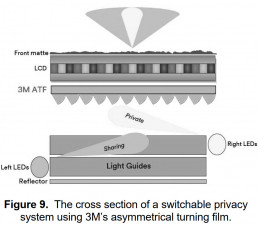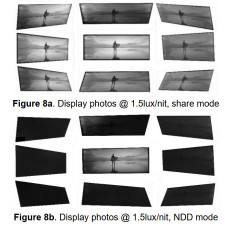I tend to think of RealD as a supplier of cinema technology in display or image processing, although it also has other technologies. I remember seeing a cool idea for changing the apparent direction that the eyes are looking to make it look as though there is direct eye contact in videoconferencing. However, today’s DD is looking at a paper* that RealD produced for the SID Vehicle Display Event in October.
RealD looked at the issue of driver distraction and proposed a dashboard display that can control what the driver can see while the passenger can see it continuously. The trend to electric vehicles and the need to minimise other power consumption to maximise vehicle range means that although the display needs to be bright, it also needs to be efficient.
The paper listed a number of ways that the potentially distracting image can be hidden from the driver in LCDs. (I realised while writing this that I don’t think that I have seen such a system for OLEDs – I guess it would need an external element to control the visibility rather than manipulating the transmission of the light as you can in an LCD). Similar technology can be used to avoid distracting reflections of, for example, a centre console display in the windscreen.
- Luminance control – using backlights that control the direction of the light emission more closely than a normal LCD to limit the field of view (FOV).
(this kind of system is used by, among others, HP in its Sure View system for privacy on notebooks .
- Reflection control – which combine the directional systems to limit the FOV combined with reflective polarisers
- Contrast control – adjusting the LCD at the pixel level in IPS and FFS modes to limit contrast
- Image camouflage – where patterned structures are used to limit the FOV
RealD said that the last two are not widely used as they reduced the quality of the image seen by the passenger.
To decide the level of difference needed between the ‘on and off’ states in distraction, RealD did experiments. These are made more tricky by the end to take into account a wide range of different eyeboxes and physiques as well as movements by the driver in the car. The firm calculated the viewing angles in a typical cabin and the levels needed to ensure ‘No Driver Distraction’ (NDD) and proposes a new metric ‘Security Factor’ that could be used to quantify the degree of driver distraction. It takes into account luminance, reflectance, contrast and ambient illuminance within the ‘NDD Headbox’.
Tests showed that to reach the level of difference between the normal and the NDD mode, backlight control alone was not enough. So, the firm added a passive retarder film and a simple extra LC layer to limit the off axis light in the NDD mode and the use of the layer made the effect electrically switchable. To further improve the effect, the researchers found that they could use similar reflective technology to that used in the HP Sure View systems. That increases the reflectivity of the display in the NDD mode and that in turn increases the size of the ‘headbox’ in which NDD performance is optimum.
Of course, that extra layer of LC to control the backlight makes it one of those dual layer LCDs that I’m always banging on about!
RealD made a test display in 12.3″ size 1920 x 720 which had over 1,000 cd/m² output to the passenger and over 300 cd/m² to the driver (and not including the reflective technology).
By chance, last week a significant step was taken towards autonomous driving in the UK. A Law Commission committee recommended https://www.bbc.co.uk/news/technology-60126014 that
- a user-in-charge cannot be prosecuted for offences arising directly from the driving task, such as dangerous driving, speeding or running a red light, but remains responsible for other tasks, including insurance and checking people are wearing seatbelts
- some vehicles may be allowed to drive themselves with no-one in the driving seat and a licensed operator responsible for overseeing the journey
- data to understand fault and liability following a collision must be accessible
- sanctions for carmakers who fail to reveal how their systems work
This kind of political and legal development is an essential part of developing autonomous vehicles. Technology alone is not going to be enough to enable the change. (BR)
* Design and Operation of Front Passenger Infotainment Displays
without Driver Distraction
Graham J. Woodgate, Michael G. Robinson,
Jonathan Harrold, Benjamin C. Ihas, Robert A. Ramsey
2021 Vehicle Displays & Interfaces Symposium




